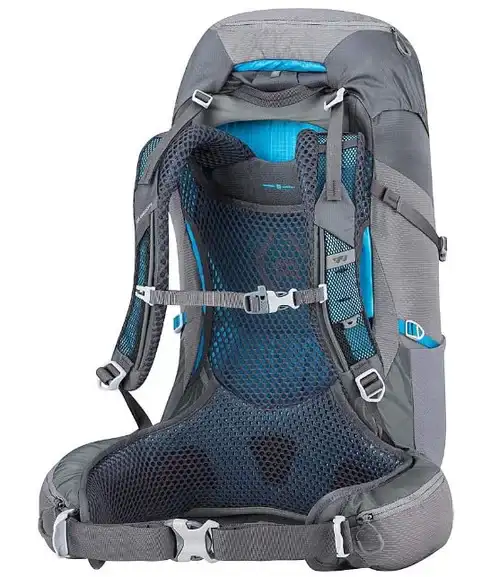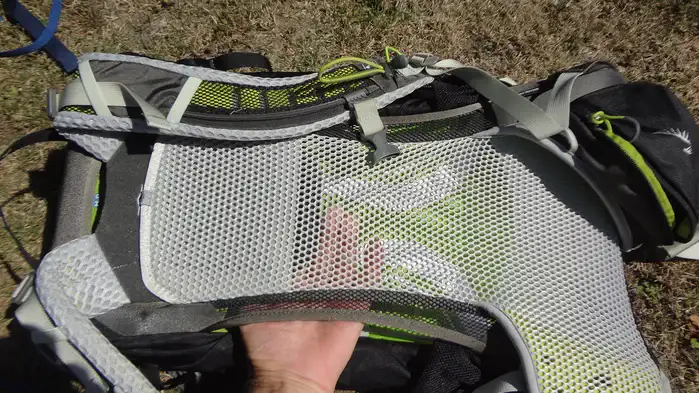The question in the title I have seen being asked at several forums. This is why I decided to write a post about this and have it as a reference. So keep reading, the answer is in the text.
If you are on a hiking and backpacking tour and you carry a pack, the annoying truth is that most likely you will be sweating if this is about a steep terrain. This holds even if you do not carry a pack.
So there is no backpack that will not make you sweat, but there are excellent designs which will reduce sweating a lot. Even if you sweat, you may experience also that on a downhill walk your back dries fast even with the pack on.
Below are some actual related questions from real people, and my answers.

What is a ventilated backpack? Why do backpacks have a mesh back?
So these are two related questions, and I think it is appropriate to answer them together. The story goes several decades ago when Deuter invented a ventilated back panel design and introduced it for the first time in their Futura backpacks.
This is what they call the Aircomfort system, one out of 6 that they currently have in their backpacks. Deuter invented it and patented in 1984. They write that with this design you have up to 25% less perspiration. They also claim this was tested by Research Institute Hohenstein.
In this Aircomfort design, the main part is its flexible spring steel frame that provides a stable tension for an airy back mesh.
This mesh is in contact with your body but the pack is completely separated from the mesh and from your back, see the picture below with a gap clearly visible. This allows air to move in all directions and it helps moist and warm air to dissipate.

My first pack of this type was Deuter Futura 38 which I bought in 2003 and I still have it. Later, I ordered their best ever Deuter Futura Vario 50 +10, it is shown on the top picture above. This Futura series was discontinued recently and replaced with the Futura Air Trek packs that are nearly identical.
I have some packs from other brands with the same design. So you realize that I have been using such ventilated packs for 21 years already.
For the purpose of this text, I made a photo of my 21 years old Deuter Futura 38 pack, as you see the delicate mesh looks intact after so many years. It is incredible how strong it is.

You can compare this old design with what they have now, this is from my Deuter Futura Vario 50+10 pack. There are differences but they are not essential, what remains all the time is the ventilated mesh instead of a back panel.

Here is my video from recent climbs in the Dolomites mountains in Italy. I stopped at a nice place on the mountain and made this short presentation of the ventilated back panel of my Deuter Futura Vario 50 + 10 pack:
This Deuter’s design was the only one on the market for decades. My guess is this had something to do with the patent mentioned above.
But in the recent years many top brands have started making backpacks with the same and perhaps even better ventilation. The picture below shows Gregory Jade pack as one example, but they have them many now.

There are many series of packs from Osprey that have such a tensioned trampoline style back panel. I would say that Osprey brought this design to perfection. You can see it in this video that shows the latest version of their Atmos and Aura AG series for men and women:

All in all, I am completely sure that there is nothing better than such a trampoline style mesh when this is about backpack ventilation. So this answers the questions in the subtitle above.
Do airflow backpacks work?
There is no doubt about this, the ventilated back panel with a trampoline style tensioned mesh definitely works. As mentioned above, Deuter has this confirmed in a testing performed by an independent source. You have seen the number, 25% less sweating.
Now, look at this from the following perspective: this should imply also that you will need less liquid to compensate for this sweating and to hydrate.
On the other hand, as mentioned in my video above, even when you sweat, this system will allow your back to dry faster. I was able to feel it just a few weeks ago in my mentioned Dolomites climbs.
How do I stop my backpack from sweating in the back?
The answer here is simple, you should go for the design described above. So instead of having a thick foam padding in contact with a big part of your back, you will have a delicate and breathable mesh in contact with the body.
So when you sweat, and you will of course, only this thin mesh may get wet. But as you stop sweating, for example when you are on a flat or downhill section, you will realize that the back is getting dry.
Why does my backpack make me sweat?
When you do some hard physical activity like hiking, mountaineering, or cycling, this generates body heat and you sweat to release the excess of the heat. If you have a pack on the back, this insulates skin and heat cannot escape so you sweat more.
This is why it is important to use synthetic clothing which dries quickly, and also use a ventilated pack design to reduce the effect described here.
Summary
So to conclude, if you carry a backpack, you will sweat a lot in particular on an uphill sections of a route, this can hardly be avoided. But backpacks with ventilated designs will reduce sweating. This may mean that you need less water to carry in the pack.
Equally important, they will allow your back to dry in intervals when you do not sweat, like in the cases when you are on a downhill section. My impression is that this effect of drying is frequently overlooked when people discuss the issue of sweating due to a heavy backpack.
You might want to read more about such and similar issues here in the site which is all about outdoors questions and activities. So check in the category FAQs. In particular, read my another text about backpacks with a ventilated hip belt.
Thank you for reading. Let me know if you have questions that you would like to have answered here. There is a comment box below.
Subscribe to my weakly newsletter and stay informed, the subscription form is given below. Thank you for reading and have a nice day.
Leave a Reply